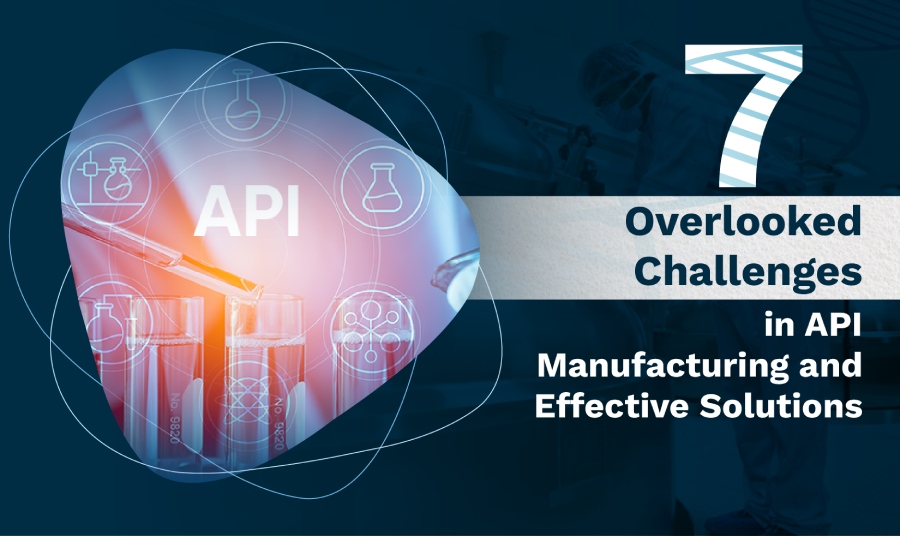Discover the top overlooked challenges API manufacturers face and practical solutions to strengthen pharma supply chains.
API (Active Pharmaceutical Ingredient) manufacturing is a cornerstone of the life sciences industry, with a direct impact on patient health and safety. As the core component in pharmaceuticals, APIs play a crucial role in ensuring that medications are effective and safe for use. However, beyond the visible logistics of production, API manufacturers face several less-discussed challenges.
Addressing these issues is essential for operational efficiency and for maintaining the highest standards of product quality and regulatory compliance. In this blog, we’ll explore seven often-overlooked challenges in API manufacturing and provide practical solutions to overcome them, ensuring that the end products meet the rigorous standards necessary for patient health and safety.
1. Navigating Complex Regulatory Requirements
Regulatory compliance is a critical aspect of API manufacturing. Keeping up with constantly changing regulations can be overwhelming, yet it is essential for avoiding legal issues and maintaining production integrity.
Solution: Establish a Robust Compliance Framework
Develop a dedicated compliance team that stays updated with current regulations. Implement compliance management systems to streamline documentation and track regulatory changes. Regular internal audits and external reviews will help ensure that your practices meet all required standards.
2. Breaking Down Information Silos
Information silos can hinder efficiency by preventing seamless communication and data sharing between departments. This can lead to delays and errors in the manufacturing process.
Solution: Adopt Integrated Systems
Utilize enterprise resource planning (ERP) systems to integrate information across all departments. This will ensure that everyone has access to accurate and up-to-date data, facilitating better coordination and decision-making. Regular cross-departmental meetings can also help in bridging communication gaps.
3. Adapting to Rigid Processes
Rigid manufacturing processes can limit a company’s ability to respond to changes in demand or production needs. This inflexibility can affect overall efficiency and product quality.
Solution: Implement Flexible Manufacturing Systems
Consider modular manufacturing systems that can be adjusted based on current requirements. Lean manufacturing techniques can also enhance flexibility by promoting continuous improvement and reducing waste. This approach allows for quicker adaptation to changing conditions.
4. Overcoming Lack of Real-Time Data
Without real-time visibility into production processes, it becomes challenging to address issues promptly and make informed decisions, leading to potential inefficiencies.
Solution: Invest in Real-Time Monitoring
Use Internet of Things (IoT) sensors and advanced analytics platforms to gain real-time insights into production processes. These technologies provide live data on equipment performance and production metrics, allowing for immediate response to any emerging problems.
5. Addressing Barriers to Remote Expertise
Accessing specialized expertise can be difficult due to physical barriers, such as distance or travel restrictions, which can impede troubleshooting and training.
Solution: Utilize Remote Collaboration Technologies
Leverage remote collaboration tools such as video conferencing and virtual diagnostics to connect with experts and conduct training sessions. Virtual reality (VR) can also be used for immersive training experiences, allowing for effective remote learning.
6. Ensuring Adequate Employee Training
Insufficient training can lead to operational inefficiencies and increased risk of errors. Proper training is crucial for maintaining high standards of production and compliance.
Solution: Develop Comprehensive Training Programs
Create and regularly update training programs that cover all aspects of the manufacturing process. Provide hands-on training and ongoing education to keep employees informed about new technologies and regulatory changes. This will help ensure that staff members are well-prepared for their roles.
7. Enhancing External Partnerships
Effective collaboration with external partners, such as suppliers and contractors, is essential for smooth manufacturing operations. Poor management of these relationships can lead to disruptions and inefficiencies.
Solution: Improve Communication and Collaboration
Establish clear communication protocols and regular meetings with external partners. Utilize collaboration platforms to streamline interactions and ensure alignment. This will help address issues quickly and maintain strong, productive relationships with all stakeholders.
Conclusion
API manufacturing involves addressing more than just logistical challenges. By tackling issues such as regulatory compliance, information silos, and process inflexibility with targeted strategies and modern technologies, manufacturers can significantly enhance their operations. Implementing these solutions will lead to improved efficiency, compliance, and overall success in the competitive pharmaceutical industry.
API Manufacturers
API Manufacturers
Comments are closed.











